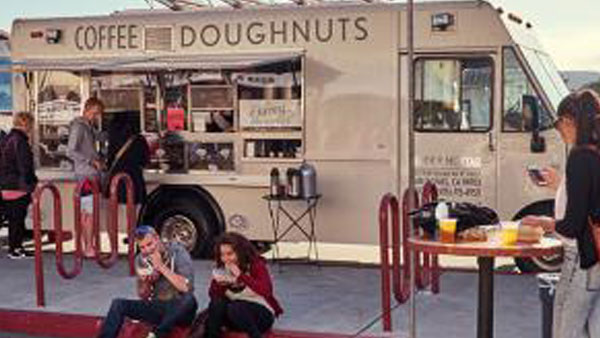Bringing food trucks into the kitchen

When food trucks burst on the scene about a decade ago, exemplified by the Kogi Korean BBQ taco truck in Los Angeles, the food world learned how a new generation wanted to eat.
Simple, chef-driven, flavorful-yet affordable-dishes are still drawing crowds to food trucks on streets and college campuses across the country. All told, 18% of consumers in general, and 26% of millennials, buy food or beverages from a food truck at least once a month, according to the Technomic 2016 Generational Consumer Trend Report. Food trucks are a top-20 concept trend in the National Restaurant Association What’s Hot 2017 Culinary Forecast. And the type of fare that trucks have helped popularize-street food-inspired tempura, pupusas, kabobs and dumplings-is the forecast’s second-hottest food trend.
Operators of rolling eateries set a helpful example for foodservice directors in optimizing workspace efficiency and keeping up with flavor trends. In addition, they have proven the usefulness of social media platforms to connect with customers, using Twitter to ensure that a group of hungry followers will be waiting when the truck rolls up.
And as takeout-only businesses, food-truck operators have been quick to adopt innovations and improvements in eco-conscious food packaging. Like Vio¬Æ biodegradable* foam from WinCup® – the first expandable polystyrene (EPS) foam cup and food container on the market that biodegrade*. When it comes to keeping hots hot and colds cold, foam can’t be beat. Pair with Vio’s biodegradable* lids and straws for a full suite of disposables that perform better – and send a confident biodegradable* eco-friendly message.
At University of Massachusetts, Amherst, launching the Baby Berk food truck five years ago meant figuring out the proper kitchen layout and ergonomics of a cramped workspace. “Just like a small galley kitchen of a busy urban restaurant, it is a very regimented atmosphere in a food truck,” says Van Sullivan, director of retail dining services at UMass.
Running a food truck in Los Angeles over the past decade has helped Susan Feniger and Mary Sue Milliken, chef-partners of the Border Grill Mexican restaurants in L.A. and Las Vegas, expand into new venues. Downsized Border Grill and Blue Window outlets operate at Los Angeles International Airport and at The Huntington, a library, museum and botanic garden in the area.
“We had never been in the quick-serve business before,” says Feniger. “[The truck] helped us think through small spaces and efficiency of storage and about how far in advance you can cook food and keep quality. It changes your mindset. It allows you to see what you can do out of a tiny space.”
Over the years, food trucks have helped operators in general understand the snacking phenomenon that has reshaped American eating behavior in the past few years. Small items with big flavors and low prices-think street tacos, sliders and skewers-are truck mainstays.
For Baby Berk, the signature item is a gourmet burger made with grass-fed beef; its four-year-old sibling, Baby Berk 2, is known for globally inspired quesadillas in flavors such as Korean spicy chicken. “We have people coming into our regular retail locations on campus who have enjoyed the food truck experience and are asking for the same kind of foods,” says Sullivan.
“A food truck dish is a one-punch fight,” Sullivan says. “It’s gotta be fast. It’s gotta be incredibly flavorful. It’s gotta knock you out with one punch.”



